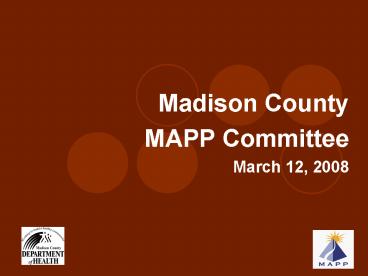Madison County - PowerPoint PPT Presentation
1 / 29
Title:
Madison County
Description:
Parks. Economic Development. Mass Transit. Employers. Nursing Homes ... State, National, and local data. Identify new data sources/needs (social determinants) ... – PowerPoint PPT presentation
Number of Views:20
Avg rating:3.0/5.0
Title: Madison County
1
- Madison County
- MAPP Committee
- March 12, 2008
2
Introductions
- MAPP Team
- Name,
- Agency,
- Interest for being on MAPP Team
- Expectations
- Assets and Contributions
3
Meeting Objectives
- Share update of activities from the Visioning
Sub-committee - Provide in-depth information about the four
assessment components - Establish assessment subcommittees and review
charge
4
Agenda
- Welcome Agenda Review
- Introductions
- Visioning Subcommittee - Update
- The Four Assessments - Presentations
- Assessment Subcommittees
- Meeting Resources Survey
- Closing
- Adjourn
5
- Visioning
- Sub-committee
6
Local Health System
Health Status
The Four Assessments
Community Themes Strengths
Forces of Change
7
Local Public Health System Assessment
Police
Home Health
Faith Organizations
MCOs
Health Department
EMS
Corrections
Parks
Hospitals
Schools
Elected Officials
Mass Transit
Environmental Health
Civic Groups
CHCs
Fire
Tribal Health
Mental Health
Drug Treatment
Laboratories
8
The Community Themes and Strengths Assessment
9
Answers the question
- What is important to community members and what
assets do we have?
10
Benefits
- Community members become more vested in the
process when they have a sense of ownership in
and responsibility for the outcomes. This occurs
when their concerns are genuinely considered. - The impressions and thoughts of community
residents help pinpoint important issues and
highlight possible solutions. - The themes and issues offer additional insight
into the findings uncovered in other assessments.
11
Three Levels of Information
- Open discussion to elicit community concerns,
opinions, and comments - Perceptions regarding community quality of life
- A map of community assets
12
- Gather Information
- Meetings
- Focus groups
- Forums
- Door to door/intercept surveys
- Mail surveys
- Interviews
- Utilize existing community groups and
organizations - Promote broad participation
- Select the best combination of techniques
13
Whats important?
- Focus on
- opportunities vs. problems
- investment vs. charity
- people vs. programs
- community organizations vs. government agencies
- citizens vs. clients
14
Findings
- Help to organize and identify key themes
- Assists in addressing cross-cutting issues from
other assessments - Useful for reporting back to MAPP Committee
- Guides work when identifying strategic issues
15
Ensure community involvement and empowerment is
sustained
- Document conversations, discussions and meetings
- Develop a master list of contacts
16
Health Status Assessment
17
Answers the questions
How healthy are our residents? What does the
health status of our community look like?
18
- Information regarding health status, quality of
life, and risk factors in the community - Basis for analyzing and identifying community
health issues - Useful for comparison to peer communities, state
and national data.
19
Data Collection
- Identify and collect data for core indicators
- Access existing databases, recent assessments or
reports - Organizational or Agency data
- State, National, and local data
- Identify new data sources/needs (social
determinants) - Tailor to local needs and or issues
- Identify and partner with research organizations
- Build on what community has already done
20
Health Profiles
- Based on data analysis and findings
- Life-course based, e.g., Adult Health Profile
- Develop visual aids that display data in an
understandable and meaningful way - Recognize and appreciate difference between data
are statistically significant and those that are
important to the community - Disseminate and share with community
21
Monitoring
- Establish a system to monitor the indicators over
time - Ensures continuing health monitoring
- Establishes baseline data upon which future
trends can be identified - Instrumental in identifying the results of the
MAPP process and evaluating success of MAPP
activities
22
Findings
- Provides a list of key challenges and
opportunities related to community health status - Identify major health problems or high risk
behaviors, cross-cutting issues, and
opportunities for improving trends - Top 10-15 issues examined during strategic issue
development - Summarized reports profile development
23
Forces of Change
24
Answers the questions
What is occurring or might occur that will
affect the community or public health
system? What specific threats or opportunities
are generated by these occurrences?
25
Forces of Change
- State and federal legislation,
- Rapid technological advances,
- Changes in the organization of health care
services, - Shifts in economic forces
- Migration in and out of community
- Changing family structures
- One-time events e.g. disaster
- Discrete elements e.g., proximity to a major
waterway or highway
26
Identifying Forces of Change
- Brainstorm to identify forces
- MAPP Committee
- Small groups
- Community forum (s)
- Newspaper clippings, national demographics,
reports, recent events, etc. - Develop list and discuss
- Consolidate like forces
- Identify threats and opportunities
- Summarize and report findings
27
Assessment Sub-Committees
- Review project summaries and charge
- Identify subcommittee members and appoint
chairperson
28
Meeting Resources Survey
29
- Closing
- What worked? What can be improved?
- Next Meeting April 9
- Agenda for next meeting
- Adjourn































